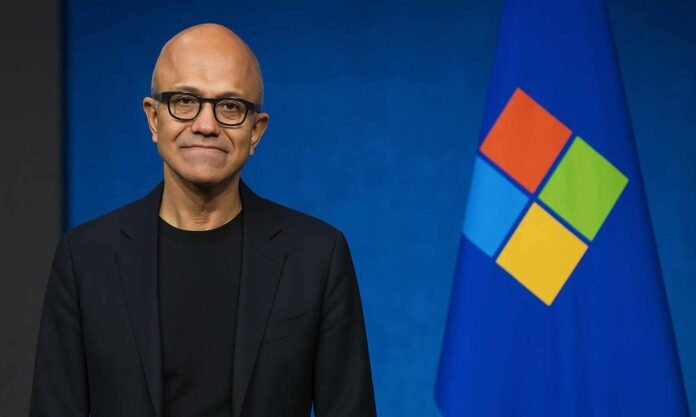- Microsoft CEO Satya Nadella’s pay rises 22 percent to $96.5 million in 2025.
- The company posts $281.7 billion in revenue, led by AI and cloud growth.
- Thousands of jobs were cut as executive pay and profits soared.
- Analysts question if AI’s profits can sustain such growth long-term.
Microsoft’s growth continues to soar, fueled by its deepening push into artificial intelligence. Yet behind the record profits and expanding data centers, the company faces criticism for widening pay gaps and ongoing layoffs.
CEO Satya Nadella’s total compensation for fiscal year 2025 will rise to $96.5 million, a 22 percent increase from last year. Most of that amount, $84 million, comes in performance-based stock awards. His base salary remains at $2.5 million.
The company says this pay package rewards Nadella’s role in driving long-term growth and shareholder value. Microsoft’s board highlighted his leadership since 2014, noting that company revenue has tripled and net income has quadrupled under his watch.
AI Power Drives Massive Profits
Microsoft’s financial report for the year ending June 30, 2025, paints a picture of extraordinary success. The company brought in $281.7 billion in revenue and earned $101.8 billion in net profit.
Much of this growth comes from its cloud and AI operations. Azure, Microsoft’s cloud computing platform, generated $75 billion in revenue, a 34 percent jump from the previous year. The company also expanded its global infrastructure, now operating 70 regions and more than 400 data centers.
Microsoft reported 430 million paid seats for Microsoft 365 Commercial, 89 million consumer subscribers, and 1.2 billion LinkedIn members. These figures underline how deeply Microsoft’s software and services are embedded in both corporate and consumer life.
The company credits its continued AI expansion for driving this momentum. Its Copilot AI tools have become central to its product strategy, with growing adoption across industries.
Rising Pay, Falling Job Security
While Microsoft’s top line is booming, life inside the company tells a more complicated story. In early 2025, Microsoft cut up to 9,000 jobs as part of internal restructuring. Those who remain are earning a median annual salary of $200,972, according to company filings.
That means Nadella’s pay is 480 times higher than the median employee’s income. This gap is larger than many tech peers and has fueled debate about fairness and corporate priorities.
Analysts say the contrast between executive rewards and job cuts raises concerns about the sustainability of Microsoft’s AI-first approach. The company continues to invest heavily in automation and data-driven tools, even as some teams see headcount reductions.
Microsoft insists these changes are strategic, designed to align its workforce with future growth areas. However, many within the industry question whether AI-driven efficiency will translate into long-term job creation or further consolidation.
AI Investments Bring Hope — And Uncertainty
Microsoft’s investment in artificial intelligence is massive. The company says 230,000 organizations now use Copilot Studio, a tool that lets businesses build custom AI assistants. It also reports that 14,000 customers are using its Azure AI Foundry service.
Yet Microsoft has not revealed how many of these customers are actually paying for those services. That omission leaves investors wondering how much revenue these new ventures are truly generating.
AI development is expensive. Microsoft has poured tens of billions into building and running its AI infrastructure. It recently acquired 100,000 of Nvidia’s high-end GB300 chips after investing $33 billion in AI startups. These investments aim to cement Microsoft’s leadership in the global AI race.
But experts say AI’s economic model remains uncertain. While AI tools promise productivity gains, monetizing them at scale may be harder than expected. Businesses experimenting with AI are still figuring out how to measure its impact on profits and operations.
Balancing Shareholder Gains With Employee Morale
Under Nadella, Microsoft has become one of the world’s most valuable companies. Its market capitalization has surged past $3 trillion, making it a cornerstone of the modern tech economy.
Still, the company’s success increasingly benefits shareholders and executives far more than its shrinking workforce. Microsoft’s focus on “long-term shareholder value” has drawn criticism from employees who feel left behind.
Tech industry analysts note that while Microsoft’s strategy has clearly delivered financial results, the human cost is becoming more visible. With each wave of job cuts, questions grow about whether the AI revolution can coexist with stable employment.
The company argues that AI will eventually create new opportunities, pointing to emerging roles in data science, cloud infrastructure, and AI engineering. But for many of those who have been laid off, those promises ring hollow in the face of immediate financial pressure.
Microsoft’s Future Depends On Its AI Gamble
As Microsoft continues to double down on AI, it faces a delicate balance between innovation and sustainability. The company’s record profits show the short-term payoff of its aggressive AI push. But maintaining that growth while keeping its workforce stable will be a tougher challenge.
The story of Microsoft today is one of contrasts. It is a company richer than ever, yet leaner in staff. It leads the global AI movement, yet faces uncertainty about how that technology will pay off in the long run.
Whether AI can continue to fund massive pay packages and shareholder returns is still an open question. For now, Microsoft’s success depends on turning its AI dreams into dependable business realities.
Follow TechBSB For More Updates

